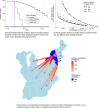From predictions to prescriptions: A data-driven response to COVID-19
- PMID: 33590417
- PMCID: PMC7883965
- DOI: 10.1007/s10729-020-09542-0
From predictions to prescriptions: A data-driven response to COVID-19
Abstract
The COVID-19 pandemic has created unprecedented challenges worldwide. Strained healthcare providers make difficult decisions on patient triage, treatment and care management on a daily basis. Policy makers have imposed social distancing measures to slow the disease, at a steep economic price. We design analytical tools to support these decisions and combat the pandemic. Specifically, we propose a comprehensive data-driven approach to understand the clinical characteristics of COVID-19, predict its mortality, forecast its evolution, and ultimately alleviate its impact. By leveraging cohort-level clinical data, patient-level hospital data, and census-level epidemiological data, we develop an integrated four-step approach, combining descriptive, predictive and prescriptive analytics. First, we aggregate hundreds of clinical studies into the most comprehensive database on COVID-19 to paint a new macroscopic picture of the disease. Second, we build personalized calculators to predict the risk of infection and mortality as a function of demographics, symptoms, comorbidities, and lab values. Third, we develop a novel epidemiological model to project the pandemic's spread and inform social distancing policies. Fourth, we propose an optimization model to re-allocate ventilators and alleviate shortages. Our results have been used at the clinical level by several hospitals to triage patients, guide care management, plan ICU capacity, and re-distribute ventilators. At the policy level, they are currently supporting safe back-to-work policies at a major institution and vaccine trial location planning at Janssen Pharmaceuticals, and have been integrated into the US Center for Disease Control's pandemic forecast.
Keywords: COVID-19; Epidemiological modeling; Machine learning; Optimization.
Conflict of interest statement
The authors have no competing interests to declare that may be relevant to the submitted work.
Figures









References
-
- Adelman D (2020) Thousands of lives could be saved in the US during the COVID-19 pandemic if states exchanged ventilators: study examines how lives could be saved by allowing US states to exchange ventilators during the COVID-19 pandemic. Health Affairs, pp 10–1377 - PubMed
-
- Billingham S, Widrick R, Edwards NJ, Klaus S (2020) COVID-19 (SARS-CoV-2) ventilator resource management using a network optimization model and predictive system demand. medRxiv
-
- Breiman L, Friedman J, Stone CJ, Olshen RA . Classification and regression trees. Boca Raton: CRC press; 1984.
MeSH terms
Grants and funding
LinkOut - more resources
Full Text Sources
Other Literature Sources
Medical
Miscellaneous

